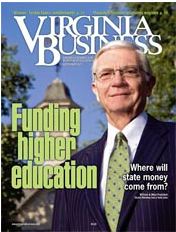Taylor Reveley, the president of the College of William & Mary, has been pushing some unsettling ideas for re-defining the university’s relationship to the commonwealth of Virginia.
State funding, which constituted 43% of the institution’s operating budget 30 years ago, now provides only 13%. The university has responded by jacking up charges for tuition, fees, room and board, which now stands at $44,854 for out-of-state students and $22,024 for in-state. The state should allow W&M to raise its in-state charges to market rates, Reveley proposes. That would mean doubling them to where out-of-state charges are now, according to this month’s Virginia Business magazine.
The university then would use a portion of the proceeds generated by families who can afford to pay full price to provide financial assistance to lower-income and middle-income families. From each according to his abilities, to each according to his needs.
It is ironic that this plan for redistributing the wealth would come from Reveley. The patrician, silver-haired, former law school dean is not anybody’s idea of a campus radical. He was appointed president in 2008 in place of left-leaning Gene R. Nichol, whose decisions on culture-war issues had plunged the campus into controversy.
The beauty of the plan, according to Reveley, is that it would not compromise affordability. “If Virginia is to sustain its system of public education, it must be creative about how to do it. I’m just deeply concerned that the money [from the state] isn’t going to be there. We’ve got to pursue other means of sustaining ourselves.”
Reveley’s plan would allow the university to grow undergraduate enrollment, a core goal of the Virginia Higher Education Opportunity Act, which calls for creating 6,000 new slots statewide for in-state students. The W&M president also calls for developing new revenue streams by means of research grants, entrepreneurial activities more aggressive fund-raising, and he recommends productivity-enhancing changes such as embracing long-distance learning and year-round use of the facilities.
The Virginia Business article, though one of the best pieces I have read about higher ed in Virginia recently, did omit one important perspective: One reason that state support has declined so dramatically is that W&M, along with the University of Virginia and Virginia Tech, agreed to second-class funding status in exchange for greater freedom from state bureaucratic control. The hope was that granting more autonomy to the three universities with the largest endowments would allow them to save considerable expense and give them more latitude in undertaking new initiatives.
If Reveley gets his way, William & Mary would take another big step toward independence, becoming more like private, non-profit colleges that charge exorbitant fees and rebate part of them back to lower- and middle-income parents.
I’m ambivalent. On the one hand, I’ve got problems with enacting another wealth-distribution scheme in order to expand capacity and admit more students who very likely will derive little benefit from attending college. On the other hand, I agree with fellow-blogger Groveton that it may make good sense for W&M, UVa and Tech to go private and become totally self supporting. That would free resources for the commonwealth to plow into George Mason University, Old Dominion University and Virginia Commonwealth University with the goal of building prestigious institutions in the state’s three main population centers that can ignite economic development.
Reluctantly, I conclude that Reveley’s proposal is a step in the right direction. We should be explicit, though, that the ultimate goal is to take W&M private.



